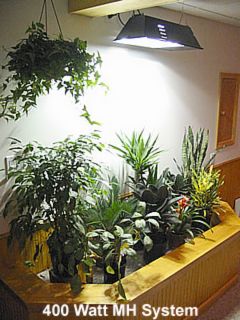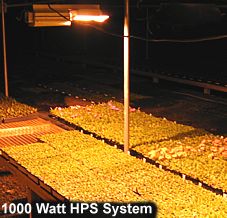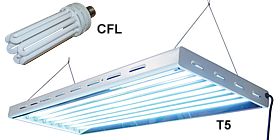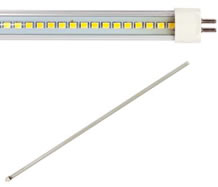Grow lighting systems allow you to extend the growing season by providing your plants with an indoor equivalent to sunlight. This is a great advantage for those of you who appreciate having a year-round supply of fresh flowers, veggies, and herbs. Plant grow lights are also a great way to jump-start spring by starting your seedlings months ahead of the last frost.
HID (High Intensity Discharge) Plant Grow Lights HID lighting is one of the most efficient ways to provide light to plants and one of the most economical because they can cover a large area with a single fixture. There are two types of HID grow lights used for horticultural lighting:

Metal Halide - MH
Metal halide bulbs produce an abundance of light in the blue spectrum. This color of light promotes plant growth and is excellent for green leafy growth and keeping plants compact. It is the best type of light to be used as a primary light source (if no or little natural sunlight is available). Metal halide grow lights produce around 125 lumens per watt (up to 6x the lumens per watt compared to with standard fluorescent lights and incandescent bulbs).
High Pressure Sodium - HPS
High pressure sodium bulbs emit an orange-red glow. This band of light triggers hormones in plants to increase flowering/budding in plants. They are the best grow lights available for secondary or supplemental lighting (used in conjunction with natural sunlight). This is ideal for greenhouse growing applications.
Not only is this a great flowering light, it has two features that make it a more economical choice. They produce up to 140 lumens per watt. Their disadvantage is they are deficient in the blue spectrum. If a plant is grown with an HPS grow light only, it would grow up thin and lanky and in no time you will have to prune your plant back before it grows into the light fixture. When used in a greenhouse or in conjunction another light source that emits light in the blue spectrum, HPS grow lights work very well. Light sources that have a high output in the blue spectrum like sunlight and MH grow lights offset any stretching caused by HPS bulbs.
Fluorescent Plant Grow Lights  CFL (compact fluorescent) and T5 full spectrum fluorescent lights are an excellent low cost option for lighting small areas indoors. At 75 to 90 lumens per watt, these lights are energy efficient and extremely effective especially when used in numbers. Fluorescent grow lights also have better color rendering properties (more of the light emitted is used by the plant) and produce much less heat than incandescent and HID grow lights. This allows them to be placed closer to plants (within a few inches) greatly decreasing light loss from the bulb to the plant. It is recommended that these lights be placed no more than a couple feet from the plants for best results. 2700k to 3000k bulbs provide higher output in the red spectrum which promotes flowering. 5000k to 6500k bulbs are full spectrum with much of the light in the blue spectrum which promote overall plant growth.
CFL (compact fluorescent) and T5 full spectrum fluorescent lights are an excellent low cost option for lighting small areas indoors. At 75 to 90 lumens per watt, these lights are energy efficient and extremely effective especially when used in numbers. Fluorescent grow lights also have better color rendering properties (more of the light emitted is used by the plant) and produce much less heat than incandescent and HID grow lights. This allows them to be placed closer to plants (within a few inches) greatly decreasing light loss from the bulb to the plant. It is recommended that these lights be placed no more than a couple feet from the plants for best results. 2700k to 3000k bulbs provide higher output in the red spectrum which promotes flowering. 5000k to 6500k bulbs are full spectrum with much of the light in the blue spectrum which promote overall plant growth.
LED Plant Grow Lights  LED grow lights are the newest lighting option for plants. They have come a long way from the days of blue and red bulbs and are now available in full spectrum natural looking lights that blend in with the surroundings. LED lights are also among the most efficient and coolest running grow lights available. We offer stand-alone LED grow light systems as well as bulbs that are compatible with standard household light sockets and T5 fluorescent fixtures. They perform as well as or better than equivalent fluorescent lights while using less electricity and lasting over twice as long.
LED grow lights are the newest lighting option for plants. They have come a long way from the days of blue and red bulbs and are now available in full spectrum natural looking lights that blend in with the surroundings. LED lights are also among the most efficient and coolest running grow lights available. We offer stand-alone LED grow light systems as well as bulbs that are compatible with standard household light sockets and T5 fluorescent fixtures. They perform as well as or better than equivalent fluorescent lights while using less electricity and lasting over twice as long.
Incandescent Plant Grow Lights  These lights are the most inefficient type of light and a poor source of light for plants. At best they can provide supplemental light to individual house plants. Incandescent lights have a low lumen output per watt compared to other grow lights and produce considerably more heat. New smaller LED grow lights like our Green Thumb system produce as much light as a 200 watt incandescent bulb with less than 1/4 of the electrical usage, and more of the light is used by the plant. These lights are the most inefficient type of light and a poor source of light for plants. At best they can provide supplemental light to individual house plants. Incandescent lights have a low lumen output per watt compared to other grow lights and produce considerably more heat. New smaller LED grow lights like our Green Thumb system produce as much light as a 200 watt incandescent bulb with less than 1/4 of the electrical usage, and more of the light is used by the plant.
|